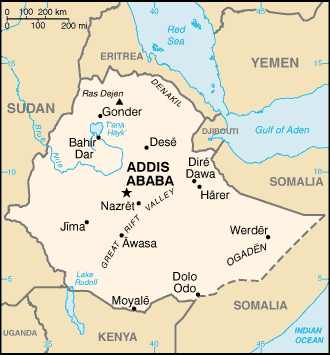Map:

Overview:
Unique among African countries, the ancient Ethiopian monarchy maintained its freedom from colonial rule, with the exception of the 1936-41 Italian occupation during World War II. In 1974 a military junta, the Derg, deposed Emperor Haile SELASSIE (who had ruled since 1930) and established a socialist state. Torn by bloody coups, uprisings, wide-scale drought, and massive refugee problems, the regime was finally toppled in 1991 by a coalition of rebel forces, the Ethiopian People's Revolutionary Democratic Front (EPRDF). A constitution was adopted in 1994 and Ethiopia's first multiparty elections were held in 1995. A two and a half year border war with Eritrea ended with a peace treaty on 12 December 2000. Final demarcation of the boundary is currently on hold due to Ethiopian objections to an international commission's finding requiring it to surrender sensitive territory.
The People:
Population: 73,053,286
note: estimates for this country explicitly take into account the effects of excess mortality due to AIDS; this can result in lower life expectancy, higher infant mortality and death rates, lower population and growth rates, and changes in the distribution of population by age and sex than would otherwise be expected (July 2005 est.)
Age structure:
0-14 years: 43.9% (male 16,082,504/female 15,999,602)
15-64 years: 53.4% (male 19,452,737/female 19,525,746)
65 years and over: 2.7% (male 905,648/female 1,087,049) (2005 est.)
Religions:
Muslim 45%-50%, Ethiopian Orthodox 35%-40%, animist 12%, other 3%-8%
Government Type:
federal republic
Leader(s) to pray for:
chief of state: President GIRMA Woldegiorgis (since 8 October 2001)
head of government: Prime Minister MELES Zenawi (since NA August 1995)
Source: The World Factbook
View All Countries